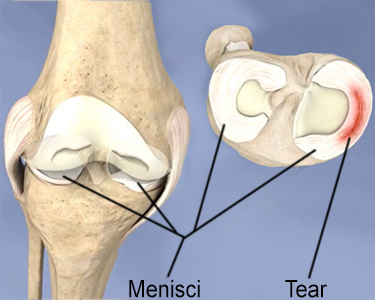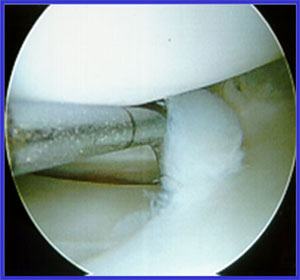Can An Untreated Mcl Injury Be Repaired
Torn Meniscus
A healthy meniscus acts equally a shock absorber and provides a polish surface for your knee to glide on. A tear in the meniscus prevents your knee from rotating, causing pain and locking. Injuries to the meniscus are mutual, especially amidst athletes.

What is the meniscus?
The meniscus is a structure in the knee joint that spans and cushions the space betwixt the femur (thighbone) and the tibia (shinbone). There are two menisci in each knee – one on the inside (the medial meniscus) and one on the outside (the lateral meniscus).
Each is made of strong fibrocartilage and is shaped similar a crescent or the letter "C." These menisci look similar suction cups that are carefully molded to the shape of the articulation surfaces of the femur and tibia.

What does the meniscus practice?
The shape and size of the meniscus allows it to serve several functions. When you stand up upward, your weight is borne evenly through your legs and down to your knees. The stress this weight places on the knee becomes even higher while walking, running and jumping. The meniscus functions as absorber to keep the basic of the knee joint from grinding against ane other and causing damage. It also transmits the load of your weigh evenly across the knee joint joint. This load-sharing helps to forbid genu injuries and is extremely important to the function and health of the articulatio genus.
An injury to the meniscus can affect the articulatio genus's ability to part commonly. The well-nigh common type of meniscus injury is a meniscal tear.
What causes a meniscal tear?
There are two basic types of meniscal tears. A traumatic meniscal tear often happens when an athlete quickly turns the body, pivoting on the genu while the foot is planted in place on the ground. A degenerative meniscal tear is caused by clothing over fourth dimension, and unremarkably affects older people.
Traumatic tears
Traumatic tears in the meniscus usually occur during forceful twisting of the knee and are common amidst players of sports such as football, basketball and soccer, but they can occur during any activeness involving knee twisting. Less ofttimes, repetitive kneeling or rising from a squatting position while lifting can atomic number 82 to a tear.
Degenerative (atraumatic) tears
Degenerative or atraumatic tears usually in older populations and are acquired by biological science and degeneration and breakdown of the meniscal structure. People with degenerative tears may have twisted their knee and accelerate the tear. Nonetheless, the tear pattern in a degenerative tear is very different from that of a traumatic tear. This is important considering the treatment for a degenerative tear may exist very different from that of a traumatic tear.
What are the symptoms of a torn meniscus?
The fundamental symptom of a meniscus tear is pain in the knee joint. A locking or communicable sensation may also be felt in the knee, and it volition frequently become inflamed (swollen). At that place may also exist a feeling of weakness in the leg and a sense of the knee joint buckling or "giving style." This is considering displaced, fragmented tissue from a torn meniscus and swelling in the knee can bear upon the thigh muscles that back up knee office.
Pain is usually felt in the articulatio genus to a higher place the meniscus while bearing weight on the affected genu and/or when twisting, turning, or pivoting on the knee, such as while getting in and out of a car. Walking up or downwards stairs may be particularly painful, and may also crusade increased swelling in the knee.
How is a torn meniscus diagnosed?
Your dr. will ask about your symptoms and the circumstances of your injury, and conduct a physical examination. Radiological imaging studies will be ordered to confirm a diagnosis: X-rays volition help dominion out fractures or other bone injuries as the cause of pain, and high-resolution magnetic resonance imaging (MRI) studies will help reveal the type and location of the tear.
What type of doctor treats meniscus tears?
If yous suspect a meniscus tear, information technology is important to be evaluated by a physiatrist, primary care sports medicine doctor, or an orthopedic surgeon who specializes in sports medicine. (Detect a doctor at HSS who treats meniscal tears.)
Will a meniscus tear heal on its ain?
The meniscus has a limited blood supply and, therefore has limited ability to heal on its own. Only the outer one-3rd of the meniscus contains blood vessels required for healing. This is known every bit the "red zone." The inner 2-thirds of the meniscus is avascular (meaning there is no blood supply) and is likewise known as the "white zone." Most meniscus tears that bear on the white zone cannot heal on their own.
Can you still walk with a torn meniscus?
Simple walking and other activities that practise not require twisting, pivoting, rapid change of direction, etc., are generally well-tolerated after a meniscus tear. Tears can progress over time, but the charge per unit of progression is generally gradual and highly variable. Hurting is the guide. If a tear is beingness made worse, there volition by and large be associated symptoms of increased pain.
What happens if yous leave a torn meniscus untreated?
Untreated tears can progress and become worse over time. Progressive meniscus loss can increase the risk that a person will develop degenerative knee arthritis. Information technology is important to become a diagnosis and seek treatment early.
What is the treatment for a torn meniscus?
Nonsurgical treatments, such as anti-inflammatory medications and rehabilitation with a physical therapist may help some people with a torn meniscus. Other patients will need surgery, unremarkably either a trimming or repair of the meniscus. Treatments may also depend on whether the tear is traumatic or degenerative.
Nonsurgical options
A non-operative physical therapy handling plan will oft focus showtime on reducing pain and maintaining the total motion of the articulatio genus. Oral nonsteroidal anti-inflammatory medications (such every bit ibuprofen) may too exist prescribed. After the initial injury pain has decreased and the knee move is restored, treatment may motility to muscle strengthening. Plasma-rich platelet (PRP) injections may be beneficial to some patients.
Degenerative tears may not accept whatsoever separated meniscal fragments that are causing mechanical symptoms in the knee. These can often be treated without surgery through bourgeois treatment.
Fragmented degenerative tears and about acute, traumatic tears volition need surgery.
What is the surgery for a torn meniscus?
If surgery is required, a genu arthroscopy is most mutual. Minimally invasive incisions in the genu will be made using an arthroscope (or "scope"), a fiberoptic camera stock-still with specialized surgical instruments. These instruments permit careful trimming (removal) of the torn meniscal fragments or, for some cases, a repair of the meniscal tear with sutures.
Since the meniscus has an of import function in the long term health and role of the knee, the surgeon will e'er attempt to retain and repair any office of the meniscus that has the blood supply and the potential to heal. Almost meniscal tears occur in the "avascular" part of the meniscus and cannot be repaired. In this case, the torn portion of the meniscus is removed. If the tear is large and occurs in a part of the meniscus with a adept blood supply, then a repair may be performed.
In some degenerative meniscus tears, a portion will fragment and this loose fragment will cause symptoms of knee catching or locking. These may crave surgical treatment. However, repair is mostly not an choice, since in most cases, the degenerated meniscus fragment has poor vascular supply and is thus not amenable to repair. Surgical treatment well-nigh often involves removal of the torn piece.
Arthroscopic meniscal surgery
In a genu arthroscopy, 2 minor incisions volition be made. An arthroscope (or "telescopic") will be passed through 1 of these to deliver saline solution that will aggrandize the knee articulation. The scope's camera allows the surgeon to see inside the articulation.
A surgical instrument is then inserted in through the other incision to perform one of the two bones operative treatments for meniscus tears:
- Trimming away the torn piece of meniscus
- Repair of the meniscus using sutures.

Arthroscopic photo of a torn meniscus
View animations of knee arthroscopy surgery to trim and repair a torn meniscus.
How long does it take to recover from meniscus tear surgery?
The time that may be required to achieve a complete recovery after surgery volition depend on the injury and the extent of meniscal surgery necessary. If a meniscus tear is repaired, and so limited weightbearing with crutches may be required for approximately four to vi weeks. On the other hand, if the torn portion of the meniscus is removed, then protected weightbearing may only be required for a few days.
A well-directed rehabilitation plan is important to reach an splendid consequence. The early rehabilitation will focus on achieving full knee motility and reducing the swelling from surgery. After this has been accomplished, the primary focus will exist on restoring muscle force. The treating dr. and physical therapist or able-bodied trainer volition carefully guide the rehabilitation after surgery.
Larn more than from the content below or find a md at HSS who can diagnose and treat a torn meniscus.
Dorsum in the Game patient stories
Source: https://www.hss.edu/condition-list_torn-meniscus.asp
Posted by: marksidest.blogspot.com


0 Response to "Can An Untreated Mcl Injury Be Repaired"
Post a Comment